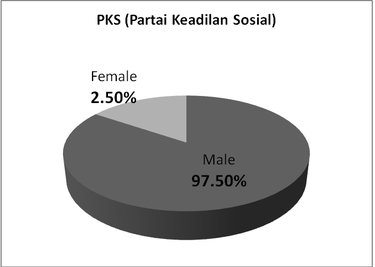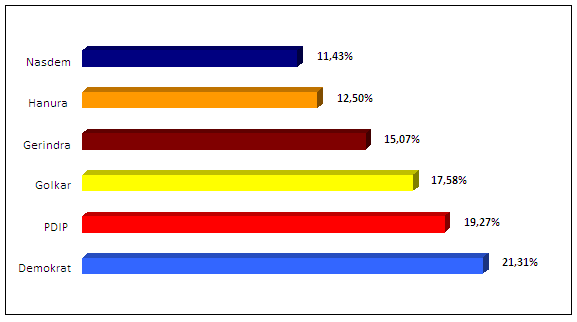|
Dr. Phil. Dewi Candraningrum Jurnal Perempuan/Indonesian Feminist Journal & Universitas Muhammadiyah Surakarta dewicandraningrum@jurnalperempuan.com  Dok. Pribadi Dok. Pribadi Background This research explains the interaction of religion and politics during the Legislative Election of April 9 and the Presidential Election of July 9, 2014 in considering the status of women and girls. Feminist approaches are often suspicious or cannot believe how the alliance of these two terms (religion and politics) can truly serve the mandate for gender justice and social justice. Currently, there are approximately 202.9 million people in Indonesia who identify as Muslim (around 88.2% from the total population of Indonesia, 237 million people). The majority are Sunni, around 1 million people are Shia, and approximately 400 thousand people are Ahmadi. Generally, there are two further categories which can be seen, modernist and traditionalist – although this is not to deny the other tendencies within the Islamic tradition. As a country with adherents of the largest religions in the world, particularly as the country with the largest Muslim population, Indonesia was surprised by the April 9 Legislative Election. Firstly, the PDIP’s share of the vote decreased and the share of the vote of religious parties increased. In 2009, the total share of the vote for self-identified Islamic parties was 29%, the lowest point for them in many general elections. While the polling predictions this year suggested their vote would be 15-25%, the results in the Legislative Election proved there had been a dramatic increase to 31-32% of the total national vote – where PKS declined by only 1 percent. This confirms the rise of Islamic ideology in the Indonesian political context, and consequently its use as a political device in the Presidential Election. Almost all parties, both secular and religious, employed a religious (Islamic) visual narrative to increase their support. The April 9, 2014 Legislative Election did not indicate an increase in Islamic ideology, however, the resilience of Islamic parties under democracy demonstrates their ability to adapt in a dynamic political climate. They have been a part of the national government during Susilo Bambang Yudhoyono’s presidency, and they have become more and more pragmatic because they have tasted power under democracy. This is what has caused them to drop a sharia agenda. Graphic 1. Result Vote from 5 parties based on Islamic religions (PPP, PKB, PAN, PKS PBB) Source: Adapted from The National Commission of Election: Result of Legislative Election 2014 & Other Political Parties. The status of Women in the Legislative Election and the Presidential Election Then what about rights, the roles of, participation of and status of women in the Legislative Election and the Presidential Election? Women were actively involved in the Legislative Election, although the mechanisms of the political parties mainly disappointed women, as was reported in many studies in Jurnal Perempuan 81 “Women Politicians” May 2014 (see Anita Dhewy’s research). The amount of women who serve within party structures is too small and the amount of women members in the parliament is decreasing. The 2014 Legislative Election is not a surprise for the women’s political movement as the amount of women in parliament decreased from 18% in 2009 to 17% in 2014. How about the room given for political action of women by Islamic parties? The proportion of women members of parliament (MP) from PPP came to 25.64%; PKB came to 21.28%; PAN came to 15.52%; while the smallest proportion was PKS with 2.50%. 97.50% of PKS seats were dominated by men. This result remains unsatisfactory, and the case of the status of women in PKS affirms an increase of misogyny in religious political parties. Graphic 2 Source: Adapted from The National Commission of Election: Result of Legislative Election 2014. Graphic 3 Source: Adapted from The National Commission of Election: Result of Legislative Election 2014. Graphic 4 Source: Adapted from The National Commission of Election: Result of Legislative Election 2014. Graph 5 Source: Adapted from The National Commission of Election: Result of Legislative Election 2014. What about the status of women in the non-religious parties, which are often referred to as nationalist or secular parties? The result was also not that surprising. Women MP’s from the Partai Demokrat surpassed one sixth of its MP’s, at 21.31% as seen in Graphic 6 following. They were followed by Partai Demokrasi Indonesia - Perjuangan with 19.27%, Golkar with 17.58%, Gerindra with 15.07%, Hanura with 12.50% while the lowest was Nasdem with 11.43%. Within the structure of parties and in the parliament, seats are still dominated my men. Women, sexual minorities and other vulnerable groups were almost unseen in the 2014 General Election. Graphic 6 Source: Percentage of Women in Legislation of 6 non religion-based parties viewed from amount member of parliament of each political party. Adapted from The National Commission of Election: Result of Legislative Election 2014. Rising Taboo and Failed Democracy: MMR & Child Marriage According to Council of Foreign Relations, Indonesia is among the ten countries in the world with the highest absolute number of child brides. Indonesia is the second highest in ASEAN after Cambodia. An estimated one of five girls in Indonesia is married before they reached 18. Worldwide 142 million girls will marry before adulthood within this decade alone (CFR, 2015). In Indonesia girls which are prone to child marriage are: 1. Girls from rural areas as twice as likely to marry as children as those from urban areas. 2. Child brides are most likely from poor families. 3. Married girls are generally less educated, either lack of opportunity or curtailment of their schooling by early marriage. Yet at present UNICEF reported that Indonesia jumps into global number especially in urban areas: in 2014 25% women aged 20-24 married by 18. This is a shocking reality for many Indonesian feminists and human-right advocates. According to the 1974 Marriage Law, the minimum legal age of marriage for girls is 16 with parental consent. Even recent research in marriage-contract in Puncak West Java, Arivia found that among girls are sexually enslaved forming half of the number of total sex-workers (Arivia & Gina, 2015 in Jurnal Perempuan 84). This number is certainly alarming. West Java is also known for its high number of trafficking and maternal mortality. Why West Java? West Java and West Kalimantan are the two key provinces of origin for trafficking in Indonesia while Riau Islands and Jakarta are main destinations and transit zones. Children are trafficked for the purposes of commercial sexual exploitation, as domestic workers, child brides, and child labourers, often sent to work in hazardous environments such as on plantations and fishing platforms, while babies are trafficked for illegal adoption and organs. Another concern includes the children of illegal migrants; one study has found that when illegal migrants bring children with them, their children are at risk of abandonment, neglect, and abuse as well as trafficking (Briant, 2005, in Silva-Leander, Annika, Report on Children and Migration for UNICEF Indonesia. UNICEF Indonesia, 2009, unpublished document). From Briant and Arivia research, it was reported that girls are the most prone victims of trafficking. Other research confirmed such findings that West Java is the provinces with the largest trafficking victims since 2013 replacing highest trafficking number in East Java (Atwar Bajari in Research on Humanities and Social Sciences Vol.3, No.5, 2013). During this time, counties and cities in West Java became the biggest of supplier women migrant workers as well as girl-brides for child marriage. They came from several areas, such as Indramayu, Cirebon, Bandung, Sukabumi, and Cianjur. Other factors that made the situation more vulnerable for girls and women are the mortality rate of mothers giving births (ICRW, 2015). Denial of SRHR education in Indonesian curriculum has increased the number of child-marriage since sex or sexuality or reproductive health then becoming a big taboo. Educating adolescent girls and boys has been a critical factor in increasing the age of marriage in Indonesia. This could be done via CSE (Comprehensive Sexual Education) and media campaign to end child marriage. This research will further unveil the connection between politics behavior and its impacts on girls’ and women’s SRHR. Bibliography Arivia, Gadis & Abby Gina. 2015. “Budaya, Seks dan Agama: Kajian Kawin Kontrak di Cisarua & Jakarta” dalam Jurnal Perempuan 84. Candraningrum, Dewi. 2012. Negotiating Veiling: Practice of Veiling in Contemporary Indonesia. EHESS: IRASEC. Council of Foreign Relations accessed Thursday 13 August 2015: 06.00 pm. http://www.cfr.org/peace-conflict-and-human-rights/child-marriage/p32096?cid=ppc-Google-grant-infoguide_child_marriage-understanding_ad&gclid=Cj0KEQjwgI6pBRDak6aRovWNqLsBEiQA8zZSLrIr1ZGK5ZvHAS_mEqizrD8FgBwJxmFl1LMaY1KFmHQaAjEe8P8HAQ#!/ International Center for Research on Women http://www.icrw.org/child-marriage-facts-and-figures Dhewy, Anita. “Bagaimana Wajah Caleg Perempuan dalam Pemilu 2014?” dalam Perempuan Politisi, Jurnal Perempuan Vol 19 N0 2 Mei 2014. Jakarta: YJP Press. TEMPO. Pasang Gambar Gus Dur, Tim Prabowo Diminta Izin. Senin 16 Juni 2014. http://pemilu.tempo.co/read/news/2014/06/16/078585395/Pasang-Gambar-Gus-Dur-Tim-Prabowo-Diminta-Izin KPU 2014. Rekapitulasi Data Pemilu 2014: Data Caleg/Aleg Jadi dalam partai-partai Islam. Diakses 15 Juli 2014. Weber, Max. 1905. The Protestant Ethic and the Spirit Capitalism (trans by Talcott Parsons in 1930). London: Unwin Hyman. Komisi Pemilihan Umum. Data Pileg dan Pilpres 2014. www.kpu.go.id diakses dari 9 April sd 22 Juli 2014. Comments are closed.
|
AuthorDewan Redaksi JP, Redaksi JP, pemerhati masalah perempuan Jurnal Perempuan terindeks di:
Archives
July 2018
|









 RSS Feed
RSS Feed